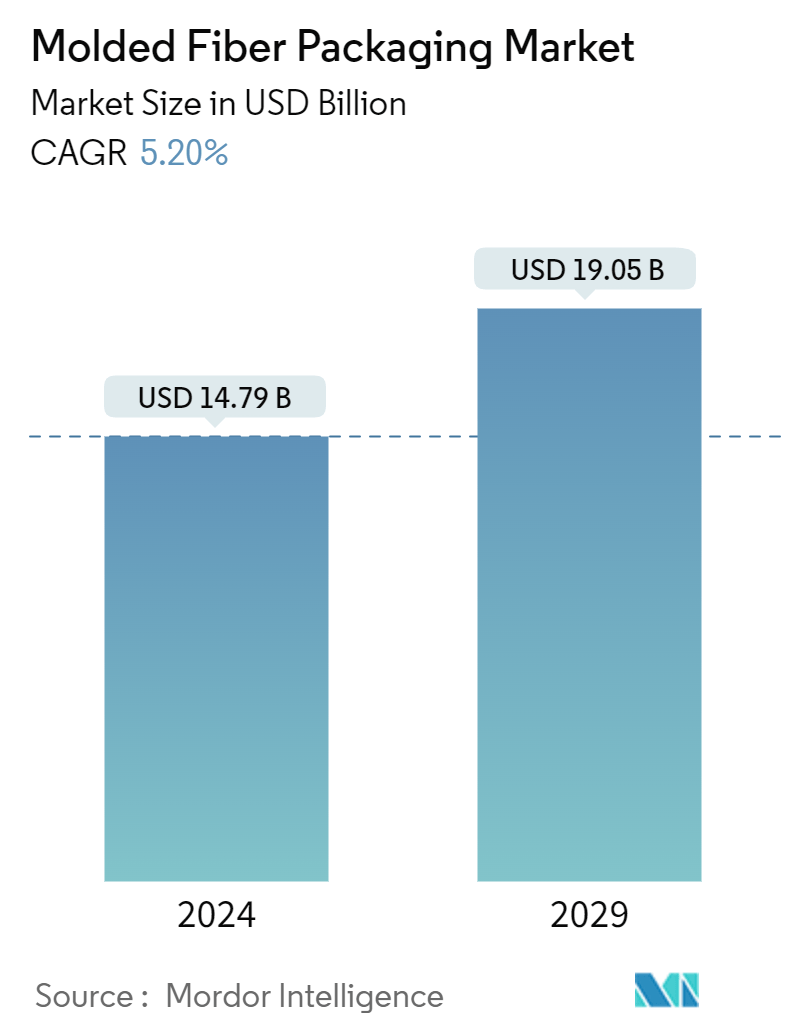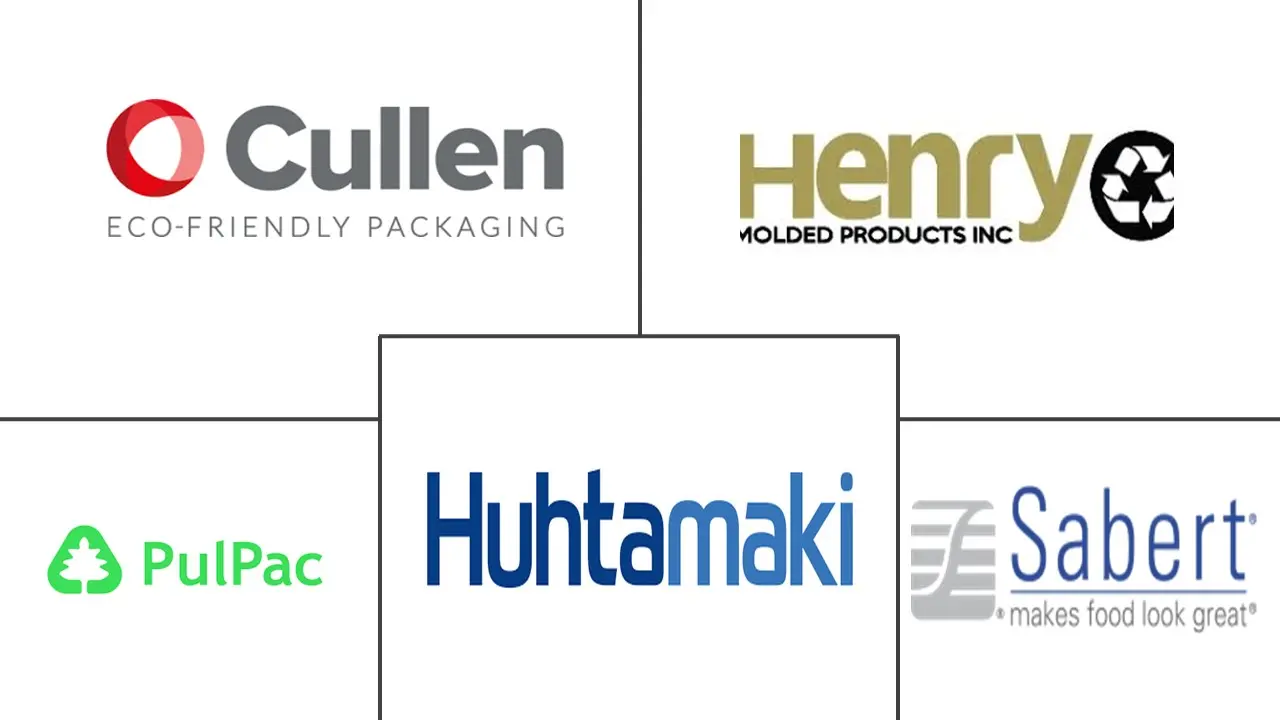Market Size of Molded Fiber Packaging Industry

| Study Period | 2019 - 2029 |
| Market Size (2024) | USD 14.79 Billion |
| Market Size (2029) | USD 19.05 Billion |
| CAGR (2024 - 2029) | 5.20 % |
| Fastest Growing Market | Europe |
| Largest Market | Europe |
| Market Concentration | Low |
Major Players
*Disclaimer: Major Players sorted in no particular order |
Molded Fiber Packaging Market Analysis
The Molded Fiber Packaging Market size is estimated at USD 14.79 billion in 2024, and is expected to reach USD 19.05 billion by 2029, growing at a CAGR of 5.20% during the forecast period (2024-2029).
The growing need for sustainable packaging made from renewable and recyclable materials shows continued interest in the potential of the molded fiber packaging market. Factors such as expanding demand in end-user industries and applying environment-protective packaging solutions are sorting the market. Waste non-wood products like wheat and bagasse are used more frequently to make pulp.
- Consumers are more aware of the long-term effects of their purchasing decisions than a decade ago. In terms of where and how to spend their money, modern consumers carefully consider their purchases. This awareness mainly focuses on package sustainability in the contemporary period as environmental concerns increase. Over 83% of younger consumers (aged 44 years and under) indicated a willingness to spend more for items that employ sustainable packaging, according to Trivium Packaging's Global Buying Green report.
- PulPac developed and owned dry molded fiber, a fiber-forming technology that can affordably and sustainably replace single-use plastic with fiber-based alternatives. Converters who set up their production can use this unique technique. PulPac created the PulPac Modula standardized machine platform with partners to hasten the transition. This platform is accessible to licensees and is available at the PulPac Tech Centre for sample and bridge volume production.
- Molded pulp packaging has been a popular option for organizations wanting to reduce their environmental impact as the packaging sector has come under greater scrutiny in recent years. Pulp-based packaging, made from fibrous materials like recycled cardboard and paper or natural fibers like bamboo, wheat, or sugarcane, is highly recyclable and can be used up to seven more times after serving its initial function.
- Producers of fast-moving consumer goods increasingly prioritize convenient and eco-friendly packaging for end users. Technological advancements and printing and coating processes for molded fiber pulp products have significantly gained traction. Even with technological shifts, this burgeoning industry is poised to maintain its trajectory during the forecast period.
- However, fluctuations in the cost of raw materials might hinder market growth. However, total fiber availability is a concern in the paper industry. Imports have climbed to 3 million tons, and numerous nations' governments have adopted import laws and restrictions and increased tariffs and excise levies. Due to a container shortage in December, international liners raised their prices.
Molded Fiber Packaging Industry Segmentation
The study covers the molded fiber packaging market tracked in terms of consumption and the sales of molded fiber packaging products offered by various vendors operating across the geographies. The consumption value of molded fiber packaging is considered in (USD) for the market size and forecasts.
The molded fiber packaging market is segmented by type (thick wall, transfer, thermoformed, and processed), formal type (wet and dry), end-user industry (food and beverages, electronics, healthcare, and other end-user industries), and geography (North America [United States and Canada], Europe [United Kingdom, France, Germany, Italy, Spain, and Rest of Europe], Asia-Pacific [China, Japan, India, and Rest of Asia-Pacific), Latin America [Brazil, Mexico, and Rest of Latin America], and Middle East and Africa [United Arab Emirates, Saudi Arabia, South Africa, and Rest of Middle East and Africa]). The market sizes and forecasts are in terms of value (USD) for all the above segments.
| By Type | |
| Thick wall | |
| Transfer | |
| Thermoformed | |
| Processed |
| By Formal Type | |
| Wet | |
| Dry |
| By End-user Industry | |
| Food and Beverages | |
| Electronics | |
| Healthcare | |
| Other End-user Industries |
| By Geography | |||||||
| |||||||
| |||||||
| |||||||
| Australia and New Zealand | |||||||
| |||||||
|
Molded Fiber Packaging Market Size Summary
The molded fiber packaging market is experiencing significant growth, driven by the increasing demand for sustainable and eco-friendly packaging solutions. This market is gaining traction as consumers become more conscious of the environmental impact of their purchasing decisions, particularly regarding packaging sustainability. The use of renewable and recyclable materials, such as waste non-wood products like wheat and bagasse, is becoming more prevalent in the production of molded fiber packaging. Innovations like PulPac's 'Dry Molded Fiber' technology are facilitating the transition from single-use plastics to fiber-based alternatives, further propelling market expansion. The food industry, in particular, is a major consumer of molded fiber packaging, with applications ranging from clam-shell containers to fruit and vegetable trays, necessitating materials that offer improved barrier properties to maintain food quality.
The market landscape is characterized by a high degree of fragmentation, with key players such as Huhtamaki OYJ, Henry Moulded Products Inc., and Br√∏drene Hartmann A/S actively expanding their operations and product offerings through strategic partnerships and acquisitions. The European region, especially Western Europe, is a significant market due to its stringent regulations on single-use plastics and a strong demand for sustainable packaging solutions. Countries like Germany, Italy, and Spain are witnessing increased adoption of molded fiber packaging, driven by urbanization, tourism, and the burgeoning e-commerce sector. Despite challenges such as raw material cost fluctuations and supply chain disruptions, the molded fiber packaging market is poised for continued growth, supported by the rising demand for environmentally friendly packaging alternatives across various industries.
Molded Fiber Packaging Market Size - Table of Contents
-
1. MARKET INSIGHTS
-
1.1 Market Overview
-
1.2 Industry Attractiveness - Porter's Five Forces Analysis
-
1.2.1 Bargaining Power of Suppliers
-
1.2.2 Bargaining Power of Buyers
-
1.2.3 Threat of New Entrants
-
1.2.4 Threat of Substitute Products
-
1.2.5 Intensity of Competitive Rivalry
-
-
1.3 Industry Value Chain Analysis
-
1.4 Import Export Analysis of Molded Fiber
-
-
2. MARKET SEGMENTATION
-
2.1 By Type
-
2.1.1 Thick wall
-
2.1.2 Transfer
-
2.1.3 Thermoformed
-
2.1.4 Processed
-
-
2.2 By Formal Type
-
2.2.1 Wet
-
2.2.2 Dry
-
-
2.3 By End-user Industry
-
2.3.1 Food and Beverages
-
2.3.2 Electronics
-
2.3.3 Healthcare
-
2.3.4 Other End-user Industries
-
-
2.4 By Geography
-
2.4.1 North America
-
2.4.1.1 United States
-
2.4.1.2 Canada
-
-
2.4.2 Europe
-
2.4.2.1 United Kingdom
-
2.4.2.2 France
-
2.4.2.3 Germany
-
2.4.2.4 Italy
-
2.4.2.5 Spain
-
-
2.4.3 Asia-Pacific
-
2.4.3.1 China
-
2.4.3.2 India
-
2.4.3.3 Japan
-
-
2.4.4 Australia and New Zealand
-
2.4.5 Latin America
-
2.4.5.1 Brazil
-
2.4.5.2 Mexico
-
-
2.4.6 Middle East and Africa
-
2.4.6.1 United Arab Emirates
-
2.4.6.2 Saudi Arabia
-
2.4.6.3 South Africa
-
-
-
Molded Fiber Packaging Market Size FAQs
How big is the Molded Fiber Packaging Market?
The Molded Fiber Packaging Market size is expected to reach USD 14.79 billion in 2024 and grow at a CAGR of 5.20% to reach USD 19.05 billion by 2029.
What is the current Molded Fiber Packaging Market size?
In 2024, the Molded Fiber Packaging Market size is expected to reach USD 14.79 billion.

